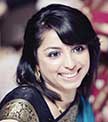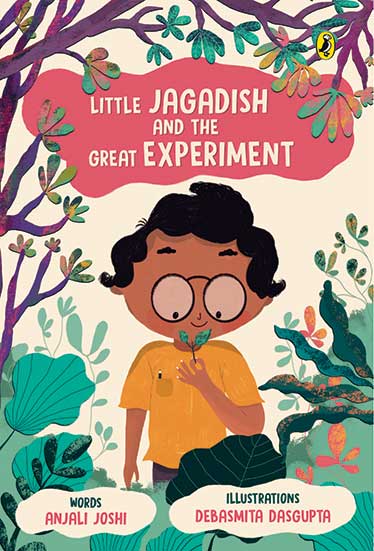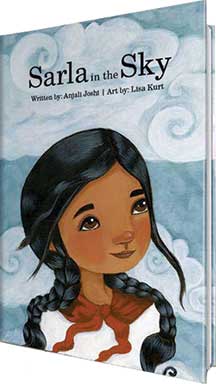Chintan Girish Modi

If you are a science teacher who likes exploring new resources to make your classroom a warm, exciting and fun place, Anjali Joshi’s book Little Jagadish and the Great Experiment (2022), would make a great addition to your school library or personal bookshelf.
Published by Puffin Books, an imprint of Penguin Random House, it draws inspiration from the life and work of Sir Jagadish Chandra Bose (1858-1937), who “was conducting groundbreaking research and gaining the attention of scientists from around the world” when India was under British rule. We meet him as an inquisitive child eager to unlock the mysteries of the universe – taking apart toys and gadgets, reading books, dissecting plants.
One day, while watering plants at school, little Jagadish says, “I wonder if, like us, plants can hear too.” His teacher, Miss Pooja, encourages him to find out for himself. Did Bose have a Miss Pooja in his life? This question popped up in my head while reading the book, and reading the author’s note helped me understand Joshi’s approach to the book. Her aim here is not to present a biographical portrait of Bose but to introduce readers to the scientific method.
Meant for ages seven and above, this book has gorgeous illustrations by Debasmita Dasgupta. Parents and teachers who want additional information about the scientist, to use this book as an educational resource, will enjoy the last three pages. They draw attention to Bose’s invention of the crescograph to measure small movements and growth in plants, and his experiments with wireless communication that led to his building a mercury coherer.
The book has a bright, happy vibe. It also contains a helpful glossary at the end, two science experiments, and a short poem that Nobel Laureate Rabindranath Tagore wrote about Bose.
We bring you an interview with Joshi, who is currently based in Toronto, Canada.
Tell us about your first encounter with the life and work of Sir Jagadish Chandra Bose? What were you struck by? What motivated you to learn more about him?
Growing up in Canada, the scientists I learned about were primarily of European descent. Names like Newton, Faraday, and Darwin were household names. I grew up believing that it was only the West that had made significant contributions to the development of scientific knowledge. As I grew older, I learned that this couldn’t be further from the truth. Scientists from all over the world had made many notable discoveries and contributions to science, but unfortunately their stories were being left out.
As a parent and educator, this bothered me a lot. I realized that we needed to change the narrative so that children could see that the progress we see today is built on the backs of non-European scientists, and their stories and contributions deserve to be celebrated with pride, not erased from our textbooks.
So, I began researching trailblazers from around the world whose stories were remarkable. I stumbled on Jagadish Chandra Bose’s life and works when I saw a Google Doodle in honour of Bose’s 158th birthday on November 30, 2016. I couldn’t believe that I hadn’t heard of him before. I was completely floored by his many discoveries, his pursuit of knowledge, and the lack of credit he received for his work.
I thought it would be interesting to write a children’s story that would introduce the scientific experimentation process through the eyes of a child while also introducing Jagadish and one of his many discoveries. The hope was that this story would intrigue children from around the world to learn more about Jagadish Chandra Bose and his contributions to science, while inspiring them to follow and embrace their own curiosities.

You pursued a Master’s degree in science education at the University of Oxford. How did that experience feed into the way you conceptualized and wrote Little Jagadish and the Great Experiment? What kind of research (books and other sources) went into writing this book?
I wrote this book in 2016 and did not begin my Master’s until 2019. While my Master’s degree did not play a role in the way I conceptualized and wrote Little Jagadish and the Great Experiment, my experiences as an educator, curriculum developer, author, and parent certainly played an important role in how I approached my Master’s education and research. I brought unique life experiences to discourses with my colleagues in the program and my research was directly related to the work I was doing in education.
In terms of research for this book, I read many papers and articles about Bose’s work. Because his lifetime of work is so diverse – he was a science fiction writer, physicist, botanist – my challenge was to focus on one particular discovery. I toyed with the idea of writing about his radio communication discovery as this was quite a significant contribution to modern science and one that he was not given credit for; however, ultimately, I felt the scientific concepts were too complex and abstract for young children. I wanted to focus on something that was concrete and children could see in the world around them, like plants.
You mention that the book was written in 2016. Why was it published only in 2022?
Between finding a publisher, editing, illustrations, and of course COVID-related delays, it took six years for Little Jagadish and the Great Experiment to finally be available to readers. Such is the nature of the publishing world!
Your book refers to Bose as “the father of Indian modern science”. Who then, according to you, would be the mother of Indian modern science? Do you think such nomenclatures tell us something about the sexism that exists in the world of science, like everywhere else?
When I think of Indian female pioneers in science, I think of Asima Chatterjee. She was a chemist and the first woman to receive a doctorate from an Indian university. She was born in 1917 into a middle-class family, which meant pursuing education was not an easy feat for her. Despite many challenges and barriers, she devoted her life to studying the medicinal properties of plants and has made significant contributions to the development of anti-epileptic drugs and anti-malarial drugs.
Science and mathematics are two disciplines that have excluded women for many, many generations. Those who made significant contributions are not given the credit they deserve. Due to sexism and subsequent lack of role models, generations of young girls have grown up believing that these fields were better suited for their male counterparts. To this day, we continue to see a significant gender gap in these disciplines and many post secondary institutions are striving to bridge this gap. I believe that when children at a young age see diverse representations of scientists and mathematicians, they can envision themselves doing the same. If they see it, they can be it. That’s why we need to ensure the stories we share with our children at home and at school include diverse perspectives and diverse lived experiences.
In the author’s note at the end, you mention that the book is not biographical. It is a reimagination of Bose’s childhood. Which fictional elements did you add? Why?
While Bose did discover that plants can respond to external stimuli in their environment and invented the crescograph, he did not make this discovery in his childhood!
As a teacher, I have seen that biographies are not a favourite book genre for young readers, but all children love a good story! I was interested in blending the two to create what we are calling “faction” – a work of fiction inspired by facts. While little is known about his early childhood, Bose was a curious boy and a high-achieving student. His father played an important role in his pursuit of science, so I included his father at the beginning of the story as well. The experiment itself has been simplified so that young children can understand some basic ideas in designing and conducting an experiment: asking a question, controlling variables, collecting data, exploring patterns, and drawing conclusions.
I loved the character of Miss Pooja, the school teacher who respects little Jagadish’s curiosity and encourages him to seek answers to his questions even if they are not available in books. Have you had teachers like that, or is this character based on you since you are a science teacher and curriculum developer yourself?
Miss Pooja is a nod to the many exceptional teachers that I have had the privilege of working with, and the kind of teacher and parent I strive to be every day. My grade 4 teacher, Mrs. Pedersen, was the same. She sparked my love of learning about the world around me by encouraging us to poke, prod, and turn things upside down. In education, we need to ensure that students are doing science – experimenting, doing field research, designing, and inventing – not just learning about science. We need to foster the natural curiosity of a child, and teachers like Miss Pooja are doing just that.
You have dedicated the book to your father-in-law, Jayant Joshi. How would you describe your relationship with him and his influence on you?
He passed away in 2020. It was fitting to dedicate the story of Jagadish Chandra Bose to Baba because he was a trailblazer in his own right. He was the first person in his family to go to the Indian Institute of Technology (IIT). As the oldest sibling, he supported and encouraged many to pursue higher education as well. I can see the incredible impact he had on my husband and his whole family. It is a good reminder that trailblazers don’t have to be famous people. Every family has their own trailblazer – that person who takes risks, succeeds against all odds and paves the way for generations to come.
Why did you choose to write much of this book in rhyming verse?
When writing this story, one of my goals was to ensure that it was accessible and interesting to young children. Rhyming stories are engaging for children, and from an educational perspective, the rhyming verse can be helpful as children begin reading independently and build reading fluency.
Debasmita Dasgupta’s illustrations complement your writing so beautifully. Could you tell us about the process of working with her and the exchanges you had?
Debasmita brought Jagadish to life! She was a dream to work with from day one. She worked very hard to ensure that the vision was executed effectively. In fact, she brought many authentic Bengali components to the illustrations, such as Miss Pooja’s bindi, her sari pattern, and various details throughout the book. It was such a collaborative process throughout, and I can only hope that future partnerships will be just as collaborative.

Before Little Jagadish and the Great Experiment, you wrote the book Sarla in the Sky (2016) based on the life of Sarla Thakral, the first Indian woman to fly an aircraft. Which other geniuses can we hope to see as protagonists in your future books?
I wrote Sarla in the Sky in 2014 when I first began researching trailblazers from around the world. As I mentioned earlier, certain fields have excluded women and aviation is one of them. Sarla’s story is another inspiring one as she chose to follow her dreams and paid no attention to society’s prescribed gender roles. I wanted to highlight incredible women like Sarla Thakral so young girls could see examples of women who accomplished great things, despite being told they could not.
I can’t share too many details about future projects just yet, but I do have many manuscripts in the works and some feature the stories of lesser-known scientists and trailblazers. I would like to continue to bring these stories to children so names like Jagadish Chandra Bose can also become household names! My hope is that children can see that modern science is not just a product of Europe, but that scientific knowledge and progress is a result of the efforts of many incredible minds around the world. Perhaps, most importantly, I hope these stories give them the role models that I never had and inspire them to do great things.
What are you working on at the moment?
2022 has been a great year for me. In addition to Little Jagadish and the Great Experiment, I have written a three-book Devi series published by Modi Toys, and a set of bilingual books is also being released by a local publisher in Canada. In addition to this, I have a non-fiction children’s book about Diwali traditions and history being released by Rockridge Press later this year. I’m working on supporting these launches over the coming months and also working on editing some manuscripts that are coming close to completion.
The interviewer is a writer, journalist, and educator. He can be reached at chintan.writing@gmail.com.
